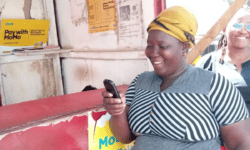A key development in our poverty alleviation mission in Zambia
New digital savings platform in Zambia
Nearly ten million people in Zambia live in extreme poverty. This means they survive on less than $1.90 per day.
Financial exclusion is a key factor impacting poverty levels (in rural regions particularly), and a disproportionate number of those financially excluded are women. Digitalisation is already helping to increase financial inclusion – we have noticed an improvement over the past five years, mainly attributable to the growth of mobile money services. However, people who live in the lowest income areas are unable to access digital financial services for a number of reasons.
Barriers to digital financial inclusion
Structural reasons include poor connectivity, infrastructure, limitations to the mobile money agent network, unreliable electricity supply, and high cost to financial institutions of servicing remote areas.
There are additional personal and gender-based barriers to accessing digital financial services such as a lack of financial and digital literacy, lack of trust in financial institutions and technology, having insufficient funds to open an account, high transaction fees, and in some cases not having access to a device.
Breaking some of these barriers and expanding digital financial inclusion could be key for economic empowerment and poverty alleviation.
Building a digital savings platform
Whilst we already disburse 100% of our loans in Zambia digitally, we now plan to expand our digital financial offerings to low-income women in our network in rural regions of Zambia. We have seen a surge in the number of clients who indicate that they want access to a safe and secure savings facility. This presents an opportunity to improve access to digital savings by building on our existing digital capabilities on network provider MTN’s mobile money platform.
Encouraging savings behaviour is a key element of our training as it is crucial for supporting women to become financially independent and build resilience. When disaster or emergency strikes, they have savings to fall back on. Without a digital means of saving, women in our network report leaving cash under their mattresses or inside pillows or drawers, which can easily be accessed by other family members, misplaced or even washed away in a devastating flood, as we saw in the first quarter of 2022.
MicroLoan Foundation Zambia is developing a digital savings facility that is specifically tailored to the poorest women in rural areas and is developed for female-led savings groups, which will tackle a gender imbalance present within existing savings group services and financial inclusion generally. Other financial service providers often overlook those at the base of the labour pyramid and have low digital savings penetration in rural regions.

How will it work?
At present, our business model focuses on providing loans and our savings facility is provided through third party institutions. We provide extensive training on savings and how and we want to strengthen women’s savings capabilities by adding a customised digital savings group functionality to our mobile banking platform in Zambia. Using existing technology is key as it is a platform that the women are used to and trust. Adding the savings group functionality will offer financial safety, security and efficiency.
As mentioned above, 100% of our loan disbursements are already made through mobile money and an assessment of our clients in 2020 shows that 85% of our clients’ households have a mobile phone. Most clients own their own mobile phones as the mobile telecommunication company MTN offer affordable, low-end phones.
As we develop the technology, test the product, and train our staff to roll out the programme, we are already including face-to-face training for women in our network to complement the digital financial services we provide. This builds trust and confidence in both the financial institution and the technology and prepares our clients for the roll out of our innovative digital savings product.
Digital savings services are scarce in rural areas, and this digital group savings product is putting MicroLoan Foundation Zambia at the very forefront of innovation in extending finance to underserved women. Not only will it encourage savings behaviour which builds resilience for women living in extreme poverty, but accessing it digitally will ensure safe, transparent, and efficient means of saving with no cost to clients. Creating a digital savings account will give the women more control and oversight over their savings, thus strengthening financial safety, increasing efficiency and enabling them to build resilience and livelihoods. This is a key development in our poverty alleviation mission which aims to expand financial inclusion in the very poorest communities in Zambia.
This will pave the way for not just MicroLoan Foundation’s clients to access this savings facility but to open up a savings facility to even those members of the community that are not receiving credit from us. Currently, over 12% of Zambians are a part of savings groups and of this, 80% are women. Once our digital savings product has been developed and tested, there is huge potential for thousands of people in rural communities in Zambia to access our digital savings facility.